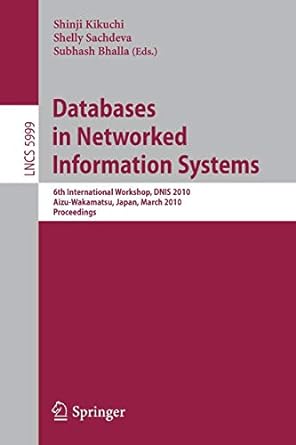Answered step by step
Verified Expert Solution
Question
1 Approved Answer
Please note the is all the information provided Assume the following tables and attributes: CUST: cid - int (4 bytes) name - char(20) (20 bytes)
Please note the is all the information provided
Assume the following tables and attributes:
CUST: cid - int (4 bytes)
name - char(20) (20 bytes)
age - int (4 bytes) - range 21 to 60
address - char(50) (50 bytes)
state - char(2) (2 bytes)
ITEM: cid - int (4 bytes)
itemid - int (4 bytes)
price - int (4 bytes) - range $1 to $100
description - char(50) (50 bytes)
- CUST is located on site 1; ITEM is located on site 2.
- There is a one-to-many relationship between CUST and ITEM where cid is the foreign key of CUST (on cid) in the ITEM table.
- CUST has hashed indexes on cid.
- There is NO index on the ITEM table.
- There are 100 CUST records and 1000 ITEM records.
- TTR is the network transfer cost per byte.
- TCPU is the cost of a CPU instruction (including disk I/O)
- TMSG is the cost of initiating and receiving a message.
- There are only two distinct states in the CUST table records (MD and VA).
Given the query: SELECT name, state, description
FROM CUST, ITEM
WHERE CUST.cid = ITEM.cid and
CUST.age > 50 and
ITEM.price > 30 and
ITEM.price <= 50
- Estimate the total cost of the query by moving the appropriate parts of the CUST table from site 1 to 2 and performing the join at site 2. To estimate the total cost, sum the cost of the estimates of each intermediate step. Assume that you are done when you have completed the join. (This is NOT a semi-join.)
Step by Step Solution
There are 3 Steps involved in it
Step: 1

Get Instant Access to Expert-Tailored Solutions
See step-by-step solutions with expert insights and AI powered tools for academic success
Step: 2

Step: 3

Ace Your Homework with AI
Get the answers you need in no time with our AI-driven, step-by-step assistance
Get Started


